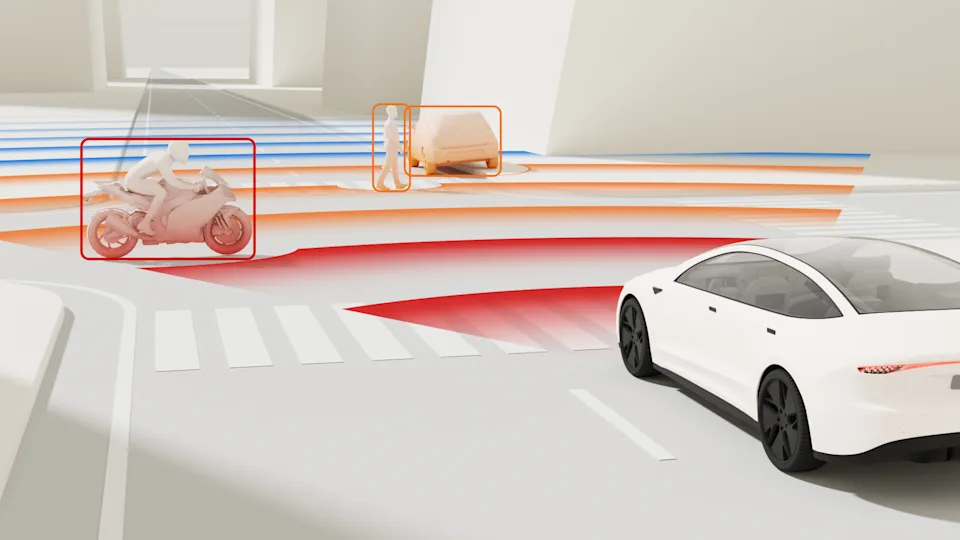YOLOv5 的量化流程及部署方法
YOLOv5 是一種高效的目標檢測算法,尤其在實時目標檢測任務中表現突出。YOLOv5 通過三種不同尺度的檢測頭分別處理大、中、小物體;檢測頭共包括三個關鍵任務:邊界框回歸、類別預測、置信度預測;每個檢測頭都會逐像素地使用三個 Anchor,以幫助算法更準確地預測物體邊界。
YOLOv5 具有多種不同大小的模型(YOLOv5n、YOLOv5s、YOLOv5m、YOLOv5l、YOLOv5x)以適配不同的任務類型和硬件平臺。本文以基于色選機數據集訓練出的 YOLOv5n 模型為例,介紹如何使用 PTQ 進行量化編譯并使用 C++進行全流程的板端部署。
本示例使用的 Yolov5n 模型,相較于公版在輸入和輸出上存在以下 2 點變動:
1、輸入分辨率設定為 384x2048,從而輸出分辨率也調整為了 48x256,24x128,12x64
2、類別數量設定為 17,因此輸出 tensor 的通道數變為了(17+4+1)x3=66
從 pytorch 導出的 onnx 模型,具體的輸入輸出信息如下圖所示:
同時,為了優化整體耗時,模型尾部的 sigmoid 計算被放在了后處理。
horizon-nn 1.1.0
horizon_tc_ui 1.24.3
hbdk 3.49.15

先準備 100 張如上圖所示的色選機數據集圖片存放在 seed100 文件夾,之后可借助 horizon_model_convert_sample 的 02_preprocess.sh 腳本幫助我們生成校準數據。
02_preprocess.sh
python3 ../../../data_preprocess.py \
--src_dir ./seed100 \
--dst_dir ./calibration_data_rgb_f32 \
--pic_ext .rgb \
--read_mode opencv \
--saved_data_type float32
preprocess.py
def calibration_transformers():
transformers = [
PadResizeTransformer(target_size=(384, 2048)),
HWC2CHWTransformer(),
BGR2RGBTransformer(data_format="CHW"),
]
return transformers
校準數據僅需 resize 成符合模型輸入的尺寸,并處理成 chw 和 rgb 即可。也就是說,除了歸一化,其他操作都要對齊浮點模型訓練時的數據預處理,而歸一化可以放到模型的預處理節點中實現加速計算。
model_parameters:
onnx_model: 'yolov5n.onnx'
march: 'bayes-e'
working_dir: 'model_output'
output_model_file_prefix: 'yolov5n'
input_parameters:
input_type_rt: 'nv12'
input_type_train: 'rgb'
input_layout_train: 'NCHW'
norm_type: 'data_scale'
scale_value: 0.003921568627451
calibration_parameters:
cal_data_dir: './calibration_data_rgb_f32'
cal_data_type: 'float32'
calibration_type: 'default'
compiler_parameters:
optimize_level: 'O3'
input_type_rt 指模型在部署時輸入的數據類型,考慮到視頻通路傳來的通常都是 nv12,因此我們將該項置為 nv12。
input_type_train 指浮點模型訓練時使用的數據類型,這里使用 rgb。
input_layout_train 指浮點模型訓練時使用的數據排布,這里使用 NCHW。
norm_type 和 scale_value 根據浮點模型訓練時使用的歸一化參數設置,這里配置 scale 為 1/255。
這樣配置后,上板模型會自帶一個預處理節點,用來將 nv12 數據轉換為 rgb 并做歸一化,這個預處理節點可以被等效轉換為卷積,從而支持 BPU 加速計算,進而顯著減少預處理耗時。
我們強烈建議您在編譯處理圖像任務的模型時,使用這種配置方法。上板模型的數據輸入類型可直接使用 nv12,同時我們也提供了板端讀取 bgr 圖片并轉換為 nv12 格式的 C++代碼供您參考。
hb_mapper makertbin --config ./yolov5n_config.yaml --model-type onnx
執行以上命令后,即可編譯出用于板端部署的 bin 模型。
=============================================================================
Output Cosine Similarity L1 Distance L2 Distance Chebyshev Distance
-----------------------------------------------------------------------------
output 0.996914 0.234755 0.000420 5.957216
613 0.997750 0.232995 0.000744 8.833645
615 0.995946 0.281512 0.001877 4.717240
根據編譯日志可看出,yolov5n 模型的三個輸出頭,量化前后的余弦相似度均>0.99,符合精度要求。
PTQ 量化流程會生成 yolov5n_quantized_model.onnx 和 yolov5n.bin,前者是量化后的 onnx 模型,后者是上板模型。通常來說,這兩個模型具有完全相同的精度,可以使用這種方法進行驗證。
yolov5n_quantized_model.onnx
import cv2
import numpy as np
from PIL import Image
from horizon_tc_ui import HB_ONNXRuntime
def bgr2nv12(image):
image = image.astype(np.uint8)
height, width = image.shape[0], image.shape[1]
yuv420p = cv2.cvtColor(image, cv2.COLOR_BGR2YUV_I420).reshape((height * width * 3 // 2, ))
y = yuv420p[:height * width]
uv_planar = yuv420p[height * width:].reshape((2, height * width // 4))
uv_packed = uv_planar.transpose((1, 0)).reshape((height * width // 2, ))
nv12 = np.zeros_like(yuv420p)
nv12[:height * width] = y
nv12[height * width:] = uv_packed
return nv12
def nv12Toyuv444(nv12, target_size):
height = target_size[0]
width = target_size[1]
nv12_data = nv12.flatten()
yuv444 = np.empty([height, width, 3], dtype=np.uint8)
yuv444[:, :, 0] = nv12_data[:width * height].reshape(height, width)
u = nv12_data[width * height::2].reshape(height // 2, width // 2)
yuv444[:, :, 1] = Image.fromarray(u).resize((width, height),resample=0)
v = nv12_data[width * height + 1::2].reshape(height // 2, width // 2)
yuv444[:, :, 2] = Image.fromarray(v).resize((width, height),resample=0)
return yuv444
def preprocess(input_name):
bgr_input = cv2.imread("seed.jpg")
nv12_input = bgr2nv12(bgr_input)
nv12_input.tofile("seed_nv12.bin")
yuv444 = nv12Toyuv444(nv12_input, (384,2048))
yuv444 = yuv444[np.newaxis,:,:,:]
yuv444_128 = (yuv444-128).astype(np.int8)
return yuv444_128
def main():
sess = HB_ONNXRuntime(model_file="./yolov5n_quantized_model.onnx")
input_names = [input.name for input in sess.get_inputs()]
output_names = [output.name for output in sess.get_outputs()]
feed_dict = dict()
for input_name in input_names:
feed_dict[input_name] = preprocess(input_name)
output = sess.run(output_names, feed_dict)
print(output[0][0][0][0])
if __name__ == '__main__':
main()
在讀取原始圖像后,將其轉換為 nv12 格式并保存,之后處理成 yuv444_128 格式并送給模型推理。
由 print(output)打印出的信息如下:
[ 0.18080421 0.4917729 0.34173843 0.26877916 -10.983349
-3.8538744 -1.8031031 -2.2803051 -1.5579813 -1.8910917
-3.7208636 -2.4970834 -2.8638227 -3.5894732 -3.338331
......
yolov5n.bin
hrt_model_exec infer --model-file yolov5n.bin --input-file seed_nv12.bin --enable_dump true --dump_format txt
這里我們將上一步保存的 nv12 數據作為 bin 模型的輸入,并保存輸出數據,其中第一個輸出分支的數據如下:
0.180804208
0.491772890
0.341738433
0.268779159
-10.983348846
-3.853874445
-1.803103089
-2.280305147
-1.557981253
-1.891091704
-3.720863581
-2.497083426
-2.863822699
-3.589473248
-3.338330984
......
可以看到,yolov5n_quantized_model.onnx 和 yolov5n.bin 具有相同的輸出。
在算法工具鏈的交付包中,ai benchmark 示例包含了讀圖、前處理、推理、后處理等完整流程的 C++源碼,但考慮到 ai benchmark 代碼耦合度較高,有不低的學習成本,不方便用戶嵌入到自己的工程應用中,因此我們提供了基于 horizon_runtime_sample 示例修改的簡易版本 C++代碼,只包含 1 個頭文件和 1 個 C++源碼,用戶僅需替換原有的 00_quick_start 示例即可編譯運行。
該 C++ demo 包含對單幀數據的讀圖(bgr->nv12),模型推理(包含預處理),后處理,打印輸出結果等步驟。
該頭文件內容主要來自于 ai benchmark 的 code/include/base/perception_common.h 頭文件,包含了對 argmax 和計時功能的定義,以及目標檢測任務相關結構體的定義。
#include
typedef std::chrono::steady_clock::time_point Time;
typedef std::chrono::duration Micro;
template
inline size_t argmax(ForwardIterator first, ForwardIterator last) {
return std::distance(first, std::max_element(first, last));
}
typedef struct Bbox {
float xmin{0.0};
float ymin{0.0};
float xmax{0.0};
float ymax{0.0};
Bbox() {}
Bbox(float xmin, float ymin, float xmax, float ymax)
: xmin(xmin), ymin(ymin), xmax(xmax), ymax(ymax) {}
friend std::ostream &operator<<(std::ostream &os, const Bbox &bbox) {
const auto precision = os.precision();
const auto flags = os.flags();
os << "[" << std::fixed << std::setprecision(6) << bbox.xmin << ","
<< bbox.ymin << "," << bbox.xmax << "," << bbox.ymax << "]";
os.flags(flags);
os.precision(precision);
return os;
}
~Bbox() {}
} Bbox;
typedef struct Detection {
int id{0};
float score{0.0};
Bbox bbox;
const char *class_name{nullptr};
Detection() {}
Detection(int id, float score, Bbox bbox)
: id(id), score(score), bbox(bbox) {}
Detection(int id, float score, Bbox bbox, const char *class_name)
: id(id), score(score), bbox(bbox), class_name(class_name) {}
friend bool operator>(const Detection &lhs, const Detection &rhs) {
return (lhs.score > rhs.score);
}
friend std::ostream &operator<<(std::ostream &os, const Detection &det) {
const auto precision = os.precision();
const auto flags = os.flags();
os << "{"
<< R"("bbox")"
<< ":" << det.bbox << ","
<< R"("prob")"
<< ":" << std::fixed << std::setprecision(6) << det.score << ","
<< R"("label")"
<< ":" << det.id << ","
<< R"("class_name")"
<< ":\"" << det.class_name << "\"}";
os.flags(flags);
os.precision(precision);
return os;
}
~Detection() {}
} Detection;
struct Perception {
std::vector det;
enum {
DET = (1 << 0),
} type;
friend std::ostream &operator<<(std::ostream &os, Perception &perception) {
os << "[";
if (perception.type == Perception::DET) {
auto &detection = perception.det;
for (int i = 0; i < detection.size(); i++) {
if (i != 0) {
os << ",";
}
os << detection[i];
}
}
os << "]";
return os;
}
};
為方便用戶閱讀,該源碼使用全局變量定義了若干參數,請用戶在實際的應用工程中,避免使用過多全局變量。代碼中已在合適的位置添加中文注釋。
#include
#include
#include
#include
#include
#include
#include
#include "dnn/hb_dnn.h"
#include "opencv2/core/mat.hpp"
#include "opencv2/imgcodecs.hpp"
#include "opencv2/imgproc.hpp"
#include "head.h"
// 上板模型的路徑
auto modelFileName = "yolov5n.bin";
// 單張測試圖片的路徑
std::string imagePath = "seed.jpg";
// 測試圖片的寬度
int image_width = 2048;
// 測試圖片的高度
int image_height = 384;
// 置信度閾值
float score_threshold = 0.2;
// 分類目標數
int num_classes = 17;
// 模型輸出的通道數
int num_pred = num_classes + 4 + 1;
// nms的topk
int nms_top_k = 5000;
// nms的iou閾值
float nms_iou_threshold = 0.5;
// 為模型推理準備輸入輸出內存空間
void prepare_tensor(int input_count,
int output_count,
hbDNNTensor *input_tensor,
hbDNNTensor *output_tensor,
hbDNNHandle_t dnn_handle) {
hbDNNTensor *input = input_tensor;
for (int i = 0; i < input_count; i++) {
hbDNNGetInputTensorProperties(&input[i].properties, dnn_handle, i);
int input_memSize = input[i].properties.alignedByteSize;
hbSysAllocCachedMem(&input[i].sysMem[0], input_memSize);
input[i].properties.alignedShape = input[i].properties.validShape;
}
hbDNNTensor *output = output_tensor;
for (int i = 0; i < output_count; i++) {
hbDNNGetOutputTensorProperties(&output[i].properties, dnn_handle, i);
int output_memSize = output[i].properties.alignedByteSize;
hbSysAllocCachedMem(&output[i].sysMem[0], output_memSize);
}
}
// 讀取bgr圖片并轉換為nv12格式再存儲進輸入內存
void read_image_2_tensor_as_nv12(std::string imagePath,
hbDNNTensor *input_tensor) {
hbDNNTensor *input = input_tensor;
hbDNNTensorProperties Properties = input->properties;
int input_h = Properties.validShape.dimensionSize[2];
int input_w = Properties.validShape.dimensionSize[3];
cv::Mat bgr_mat = cv::imread(imagePath, cv::IMREAD_COLOR);
cv::Mat yuv_mat;
cv::cvtColor(bgr_mat, yuv_mat, cv::COLOR_BGR2YUV_I420);
uint8_t *nv12_data = yuv_mat.ptr();
auto input_data = input->sysMem[0].virAddr;
int32_t y_size = input_h * input_w;
memcpy(reinterpret_cast(input_data), nv12_data, y_size);
int32_t uv_height = input_h / 2;
int32_t uv_width = input_w / 2;
uint8_t *nv12 = reinterpret_cast(input_data) + y_size;
uint8_t *u_data = nv12_data + y_size;
uint8_t *v_data = u_data + uv_height * uv_width;
for (int32_t i = 0; i < uv_width * uv_height; i++) {
if (u_data && v_data) {
*nv12++ = *u_data++;
*nv12++ = *v_data++;
}
}
}
// 后處理的核心代碼(不包括nms),初步篩選檢測框
void process_tensor_core(hbDNNTensor *tensor,
int layer,
std::vector &dets){
hbSysFlushMem(&(tensor->sysMem[0]), HB_SYS_MEM_CACHE_INVALIDATE);
int height, width, stride;
std::vector> anchors;
if(layer == 0){
height = 48; width = 256; stride = 8; anchors = {{10, 13}, {16, 30}, {33, 23}};
} else if (layer == 1){
height = 24; width = 128; stride = 16; anchors = {{30, 61}, {62, 45}, {59, 119}};
} else if (layer == 2){
height = 12; width = 64; stride = 32; anchors = {{116, 90}, {156, 198}, {373, 326}};
}
int anchor_num = anchors.size();
auto *data = reinterpret_cast(tensor->sysMem[0].virAddr);
for (uint32_t h = 0; h < height; h++) {
for (uint32_t w = 0; w < width; w++) {
for (int k = 0; k < anchor_num; k++) {
double anchor_x = anchors[k].first;
double anchor_y = anchors[k].second;
float *cur_data = data + k * num_pred;
float objness = cur_data[4];
if (objness < score_threshold)
continue;
int id = argmax(cur_data + 5, cur_data + 5 + num_classes);
// 模型檢測頭不包含sigmoid算子,而將sigmoid計算安排在后處理進行
double x1 = 1 / (1 + std::exp(-objness)) * 1;
double x2 = 1 / (1 + std::exp(-cur_data[id + 5]));
double confidence = x1 * x2;
if (confidence < score_threshold)
continue;
float center_x = cur_data[0];
float center_y = cur_data[1];
float scale_x = cur_data[2];
float scale_y = cur_data[3];
double box_center_x =
((1.0 / (1.0 + std::exp(-center_x))) * 2 - 0.5 + w) * stride;
double box_center_y =
((1.0 / (1.0 + std::exp(-center_y))) * 2 - 0.5 + h) * stride;
double box_scale_x =
std::pow((1.0 / (1.0 + std::exp(-scale_x))) * 2, 2) * anchor_x;
double box_scale_y =
std::pow((1.0 / (1.0 + std::exp(-scale_y))) * 2, 2) * anchor_y;
double xmin = (box_center_x - box_scale_x / 2.0);
double ymin = (box_center_y - box_scale_y / 2.0);
double xmax = (box_center_x + box_scale_x / 2.0);
double ymax = (box_center_y + box_scale_y / 2.0);
double xmin_org = xmin;
double xmax_org = xmax;
double ymin_org = ymin;
double ymax_org = ymax;
if (xmax_org <= 0 || ymax_org <= 0)
continue;
if (xmin_org > xmax_org || ymin_org > ymax_org)
continue;
xmin_org = std::max(xmin_org, 0.0);
xmax_org = std::min(xmax_org, image_width - 1.0);
ymin_org = std::max(ymin_org, 0.0);
ymax_org = std::min(ymax_org, image_height - 1.0);
Bbox bbox(xmin_org, ymin_org, xmax_org, ymax_org);
dets.emplace_back((int)id, confidence, bbox);
}
data = data + num_pred * anchors.size();
}
}
}
// nms處理,精挑細選出合適的檢測框
void yolo5_nms(std::vector &input,
std::vector &result,
bool suppress) {
std::stable_sort(input.begin(), input.end(), std::greater());
std::vector skip(input.size(), false);
std::vector areas;
areas.reserve(input.size());
for (size_t i = 0; i < input.size(); i++) {
float width = input[i].bbox.xmax - input[i].bbox.xmin;
float height = input[i].bbox.ymax - input[i].bbox.ymin;
areas.push_back(width * height);
}
int count = 0;
for (size_t i = 0; count < nms_top_k && i < skip.size(); i++) {
if (skip[i]) {
continue;
}
skip[i] = true;
++count;
for (size_t j = i + 1; j < skip.size(); ++j) {
if (skip[j]) {
continue;
}
if (suppress == false) {
if (input[i].id != input[j].id) {
continue;
}
}
float xx1 = std::max(input[i].bbox.xmin, input[j].bbox.xmin);
float yy1 = std::max(input[i].bbox.ymin, input[j].bbox.ymin);
float xx2 = std::min(input[i].bbox.xmax, input[j].bbox.xmax);
float yy2 = std::min(input[i].bbox.ymax, input[j].bbox.ymax);
if (xx2 > xx1 && yy2 > yy1) {
float area_intersection = (xx2 - xx1) * (yy2 - yy1);
float iou_ratio =
area_intersection / (areas[j] + areas[i] - area_intersection);
if (iou_ratio > nms_iou_threshold) {
skip[j] = true;
}
}
}
result.push_back(input[i]);
// 打印最終篩選出的檢測框的置信度和位置信息
std::cout << "score " << input[i].score;
std::cout << " xmin " << input[i].bbox.xmin;
std::cout << " ymin " << input[i].bbox.ymin;
std::cout << " xmax " << input[i].bbox.xmax;
std::cout << " ymax " << input[i].bbox.ymax << std::endl;
}
}
// 多線程加速后處理計算
std::mutex dets_mutex;
void process_tensor_thread(hbDNNTensor *tensor, int layer, std::vector &dets){
std::vector local_dets;
process_tensor_core(tensor, layer, local_dets);
std::lock_guard lock(dets_mutex);
dets.insert(dets.end(), local_dets.begin(), local_dets.end());
}
void post_process(std::vector &tensors,
Perception *perception){
perception->type = Perception::DET;
std::vector dets;
std::vector threads;
for (int i = 0; i < tensors.size(); ++i) {
threads.emplace_back([&tensors, i, &dets](){
process_tensor_thread(&tensors[i], i, dets);
});
}
for (auto &thread : threads)
thread.join();
yolo5_nms(dets, perception->det, false);
}
int main(int argc, char **argv) {
//初始化模型
hbPackedDNNHandle_t packed_dnn_handle;
hbDNNHandle_t dnn_handle;
const char **model_name_list;
int model_count = 0;
hbDNNInitializeFromFiles(&packed_dnn_handle, &modelFileName, 1);
hbDNNGetModelNameList(&model_name_list, &model_count, packed_dnn_handle);
hbDNNGetModelHandle(&dnn_handle, packed_dnn_handle, model_name_list[0]);
std::cout<< "yolov5 demo begin!" << std::endl;
std::cout<< "load model success" <
用戶可將頭文件和源碼放入 horizon_runtime_sample/code/00_quick_start/src 路徑,并執行 build_x5.sh 編譯工程,再將 horizon_runtime_sample/x5 文件夾復制到開發板的 /userdata 目錄,并在 /userdata/x5/script/00_quick_start/ 路徑下存放上板模型、測試圖片等文件,并編寫板端運行腳本:
bin=../aarch64/bin/run_mobileNetV1_224x224
lib=../aarch64/lib
export LD_LIBRARY_PATH=${lib}:${LD_LIBRARY_PATH}
export BMEM_CACHEABLE=true
${bin}
運行結果如下:
yolov5 demo begin!
load model success
prepare intput and output tensor success
read image to tensor as nv12 success
model infer time: 7.763 ms
model infer success
score 0.365574 xmin 1448.69 ymin 148.4 xmax 1518.55 ymax 278.487
postprocess time: 1.376 ms
postprocess success
release resources success
yolov5 demo end!
對于這次推理,我們的輸入圖像為下圖:
可以看到,推理程序成功識別到了 1 枚瓜子,并且給出了正確的坐標信息。
需要強調的是,應用程序在推理第一幀的時候,會產生加載推理框架導致的額外耗時,因此運行該程序測出的模型推理耗時是偏高的。
準確的模型的推理時間應當以 hrt_model_exec 工具實測結果為準,參考命令:
hrt_model_exec perf --model-file ./yolov5n.bin --thread-num 1(測試單線程單幀延時,關注latency)
hrt_model_exec perf --model-file ./yolov5n.bin --thread-num 8(測試多線程極限吞吐量,關注FPS)
*博客內容為網友個人發布,僅代表博主個人觀點,如有侵權請聯系工作人員刪除。










